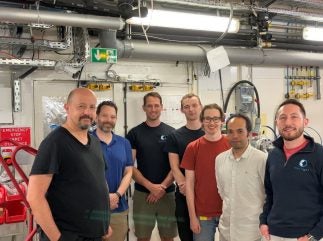
First Light Fusion reports what it believes is a new experimental milestone at the European Synchrotron Radiation Facility (ESRF) in Grenoble, France.
First Light scientists, in collaboration with the University of Oxford’s Department of Engineering Science, on 3 October performed an experiment on the ID19 beamline to investigate the formation and transit of shock waves through some of First Light Fusion’s amplifiers. First Light’s amplifier technology is central to its unique approach to inertial fusion. The amplifier focuses the input energy from a projectile, boosting the pressure from the impact to create a fusion reaction from its output.
The experimental team has been funded by the AMPLIFI Prosperity Partnership. Over two days, the team used a single-stage meso-scale gas launcher to fire aluminium projectiles at speeds around 800 m/s into different types of amplifiers. A diagnostic technique called ‘X-ray phase contrast imaging’ was then used to capture the shock dynamics occurring inside the amplifier and the resulting shock exiting the amplifier into an attached plastic sample.
The experiment was highly successful, enabling the team to capture high quality images of the shock formation and motion. This data will be used to validate the performance of First Light’s amplifiers by comparing the results with numerical simulations of the experiment done with state-of-the-art hydrodynamics codes. This will enable high quality benchmarking of the effect of material strength on the amplifier performance at these velocity regimes.
The Prosperity Partnership, jointly funded by the UK Research and Innovation (UKRI) and First Light Fusion, sponsors critical research into inertial fusion energy. In collaboration with Imperial College London, the University of York, the University of Oxford and Mach42 Ltd (formerly Machine Discovery), it aims to foster academic collaboration, provide valuable up-skilling and training opportunities, and ultimately solve the problem of fusion energy.
Francisco Suzuki-Vidal, leader of the Collaborative Experiments Group at First Light Fusion, said: “The progress the team made with these experiments is a crucial step in our journey to delivering commercial fusion at scale. We look forward to continue working with our academic and industry partners through our Prosperity Partnership AMPLIFI on more ground-breaking research in the future.”
Daniel Eakins, professor of Engineering Science, said: “It’s exceptionally rewarding to see the techniques we’ve developed successfully applied to freeze shock waves in their tracks. Visualising how these waves interact and develop within the amplifier is key to understanding and optimising their behaviour.”






